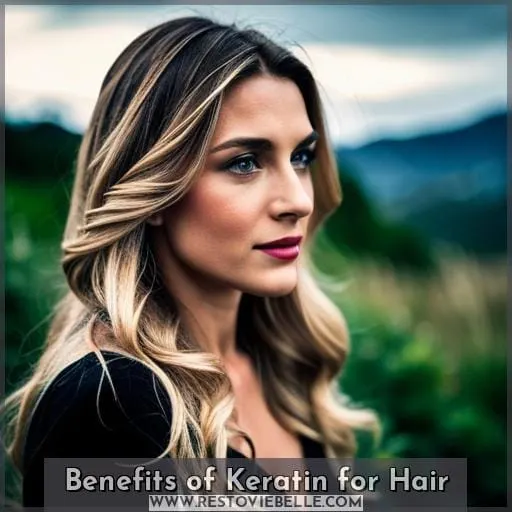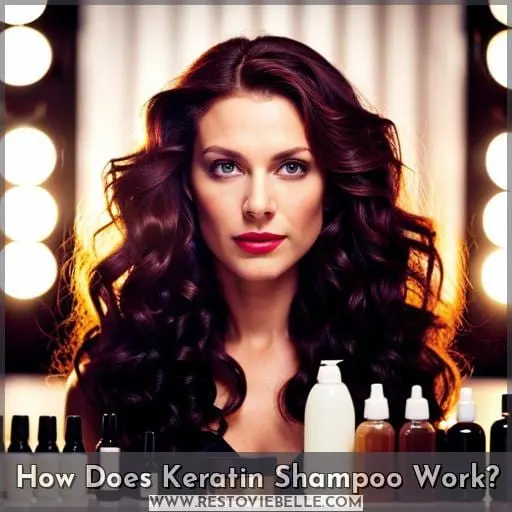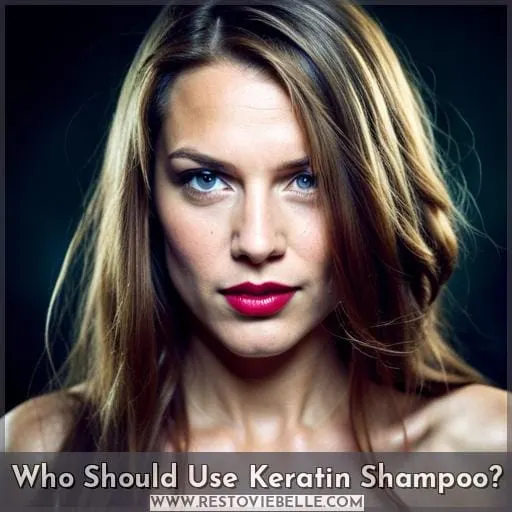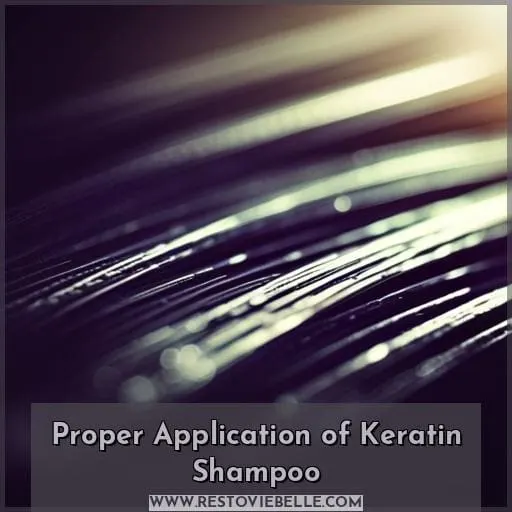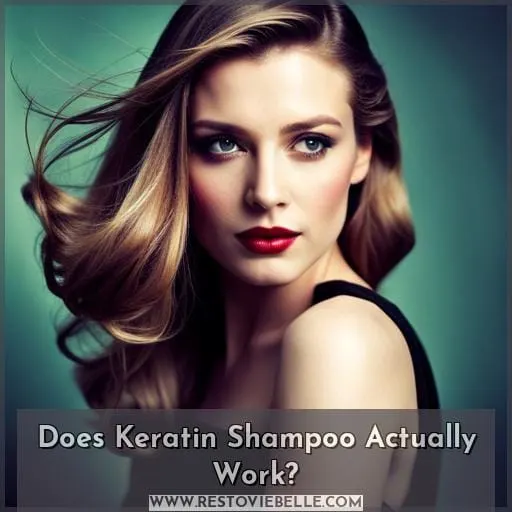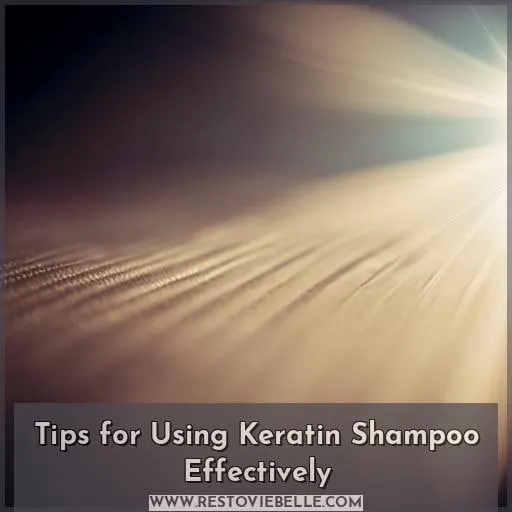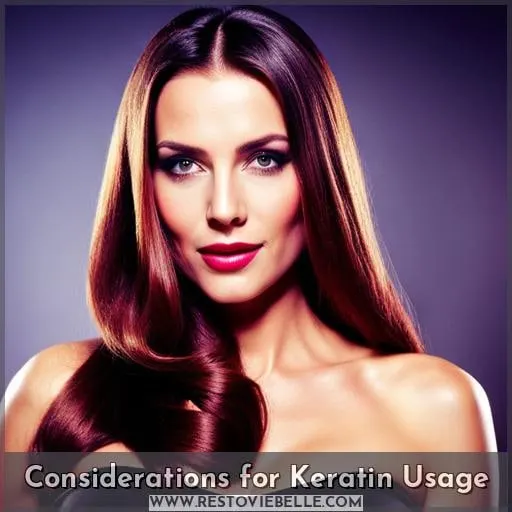This site is supported by our readers. We may earn a commission, at no cost to you, if you purchase through links.
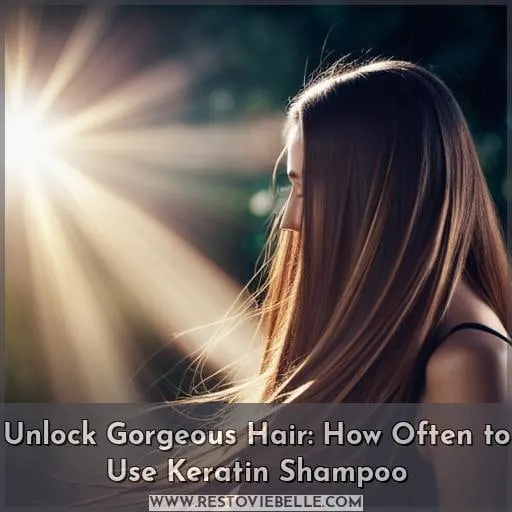 Like a phoenix rising from the ashes, keratin shampoo is here to help repair your damaged tresses. This protein-rich product can be used to strengthen and fortify hair of all types – but how often should you use it? As with most things in life, there isn’t one straightforward answer.
Like a phoenix rising from the ashes, keratin shampoo is here to help repair your damaged tresses. This protein-rich product can be used to strengthen and fortify hair of all types – but how often should you use it? As with most things in life, there isn’t one straightforward answer.
Depending on your hair type and lifestyle habits, the frequency of using keratin shampoo could vary significantly.
Table Of Contents
- Key Takeaways
- What is Keratin Shampoo?
- Benefits of Keratin for Hair
- How Does Keratin Shampoo Work?
- Who Should Use Keratin Shampoo?
- How Often to Use Keratin Shampoo
- Proper Application of Keratin Shampoo
- Does Keratin Shampoo Actually Work?
- Tips for Using Keratin Shampoo Effectively
- Considerations for Keratin Usage
- The Final Takeaway
- Conclusion
Key Takeaways
- The recommended usage frequency of keratin shampoo is up to three times weekly.
- Adjust the usage based on hair type, lifestyle, exercise, air conditioning, and heat tools.
- Excessive use of keratin shampoo can lead to stiffness, breakage, and dullness.
- Balance moisture and protein levels using the tissue paper test.
What is Keratin Shampoo?
With the power of keratin, you can make your hair stronger, smoother, and repaired – all without damaging it. Keratin shampoo is a protein-based product that helps protect against thermal damage while texturizing and hydrating hair.
It’s important to use this type of shampoo as part of a regular hair care regimen to prevent buildup or other hazards like stickiness. Depending on individual needs and preferences, it is recommended to use keratin shampoo up to three times weekly.
Using it more than that could lead to protein overload, resulting in dullness and dryness.
For best results when using keratin shampoos, wet your hair thoroughly, then apply the product evenly with gentle massage movements before rinsing well. This provides maximum protection from heat styling tools such as blow dryers or curling irons.
Follow up by adding conditioner for added nourishment into the core shafts of each strand.
With proper usage combined with supplements like ACV rinses, hot oil treatments, or deep conditioning regimes, one will surely see positive outcomes when incorporating proteins within their hair care routine!
Benefits of Keratin for Hair
If you’re looking for ways to keep your hair healthy, keratin could be the answer. Keratin is a protein that naturally occurs in hair and nails and can provide many benefits when it comes to hair care.
With its ability to strengthen the bonds between strands of hair, it helps make them more resistant against styling damage such as split ends or heat-related damage from curling irons or blow dryers. It also provides protection from environmental elements like UV radiation, which can have damaging effects on our locks over time.
There are both in-salon treatments available for those who want a professional approach and at-home products like shampoos, which contain hydrolyzed keratin that will help maintain healthy levels of this important protein within our tresses without having to visit salons regularly!
For maximum benefit, ensure you’re getting enough dietary intake and avoid using excessive cleaning ingredients. Use protective methods when applying heat tools and find products with strengthening properties tailored specifically towards your particular type of scalp/hair needs (e.
Ultimately, incorporating products containing natural keratin into your routine should lead to smoother, healthier tresses – just remember not to overdo it!
How Does Keratin Shampoo Work?
By incorporating a keratin shampoo into your hair care regimen, you can reap the rewards of stronger and smoother locks. Keratin shampoo works by replenishing natural proteins in the hair to repair damage and lock in styles with heat protection.
It helps prevent protein overload, which leads to dryness, dullness, stiffness, or breakage.
To get maximum results from your keratin-infused products, use an ACV rinse before conditioning for extra nourishment and moisture balance. For a more intense treatment, opt for an in-salon keratin treatment. This treatment might involve formaldehyde exposure but provides longer-lasting effects on damaged locks than regular home hair products do.
It does not come with the risks of a burning sensation usually associated with salon services.
Alternatives like hot oil treatments or deep conditioning will also help improve texture while protecting against future damage.
Who Should Use Keratin Shampoo?
You’ll want to consider who should use keratin shampoo when incorporating it into your routine for optimal results. Both gray-haired and dyed tresses can reap the benefits. Generally, those with dry or damaged hair due to chemical processing will benefit from a silicone-free formula that helps repair split ends and prevent further damage.
Oily hair types may find that this type of product is too heavy, but conditioning treatments can be used in lieu of regular shampooing if desired. Heat protection is another key element in using keratin shampoos, as chemicals combined with heat styling are known to dull the texture of hair over time.
For anyone looking for an overall improvement in their locks’ health and appearance without weighing them down excessively, a weekly regimen utilizing these specialized products could work wonders! Split end prevention combined with deep conditioning will help restore shine while also providing vital moisture balance, ultimately resulting in healthier-looking strands every day!
How Often to Use Keratin Shampoo
When it comes to using keratin shampoo, the hair type is a key factor. An easy way to check your hair type is by doing the tissue paper test; if you have oily roots and dry ends, then this can indicate that you have a combination of greasy and dry hair.
If neither end nor root are too oily or too dry, then this indicates normal-neither oily nor dry-hair.
For those with both greasy as well as very dry strands, it’s best to use an even smaller amount of keratin shampoo than usual for more effective results in maintaining balance between moisture and protein levels in the scalp while keeping their locks healthy.
Other deciding factors include exercising regimen level (less exercise means less sweat on head), air conditioners used (cooler settings mean lesser damage), use of other products such as styling sprays/gels before washing our manes (which may lead buildup over time), amongst others like heat or chemically treated tresses along with colored ones which require extra care due to its sensitive nature.
Ultimately speaking though, everyone’s individual needs should be taken into account when considering how often one should regularly use Keratin Shampoo.
Hair Type
It’s important to consider your hair type before using keratin shampoo, as different textures may require varying levels of protein and moisture.
Natural oils should be balanced for healthy locks and to avoid split ends.
Heat styling can further damage the hair if not protected with a heat protectant spray or another product that contains keratin oil for strengthening bonds between strands.
Protein overload is also possible from overusing this type of shampoo, resulting in dryness and brittle tresses.
Hair strength needs to be taken into account when considering the benefits of keratin treatments. This allows you to reap the rewards without risking overdosing on protein or stripping away natural oils.
Tissue Paper Test
To check if you need to use keratin shampoo, try the tissue paper test. Take a single sheet of tissue and run it through your strands.
Trichologists recommend this method as an easy way to determine whether protein overload is present or not. Alternatives like ACV rinses and deep conditioning can help replenish natural keratin levels in damaged hair shafts when used alongside a heat protectant spray.
For best results, seek advice from professionals who are well-versed in both structural proteins like keratin and hair treatments such as salon-grade smoothing services.
Greasy Hair
If you have greasy hair, keratin shampoo can help balance the moisture and protein levels in your locks to leave them feeling smoother. To avoid buildup or an oily scalp, try mild shampoos with natural oils such as argan oil.
Opt for alternatives like liquid keratin treatments or ACV rinses instead of regular shampooing. Use a deep conditioning mask once a week to nourish dry hair. Apply Keratin Shampoo only 2-3 times per week.
Always remember that too much protein overload can lead to stiff, dull, easily breakable locks, so be sure not to overuse it! Regularly moisturize your strands with natural oil to help restore their bounce while keeping grease at bay.
Smoothing conditioners are also great for adding shine without weighing down the texture of your tresses.
Dry Hair
For dry hair, you may want to give keratin a try – it can help repair damage and lock in styles. Protein overload is a common problem with overuse of keratin shampoo, so limit use to three times per week.
Alternatives like ACV rinses, hot oil treatments, and deep conditioning are also beneficial for normal or colored hair.
For greasy locks, mineral oils can help promote healthy growth without the need for harsh chemicals or protein overloads that cause breakage and dullness.
Keratin offers many benefits that make it an ideal choice to condition dry hair, but remember balance is key!
Normal Hair (Neither Oily Nor Dry)
If your hair is neither oily nor dry, using a keratin shampoo up to three times per week can help protect and nourish it. A conditioner should also be used, as well as heat protection when styling. Regular scalp health checks are important too.
This helps prevent damage that could lead to needing repair treatments with the haircare ingredient keratin.
Hair cleansing products should not be overused. Instead, aim for twice a week plus an occasional deep cleanse with hot oil or ACV rinse treatment if necessary. Incorporate good hair habits into your routine, such as avoiding tight styles and brushing gently when wet.
Dry Greasy Hair
If your hair tends to get dry and greasy at the same time, try using a keratin shampoo every other week. The protein overload caused by using too much can result in dullness and breakage. Consider ACV rinses or hot oil treatments as an alternative if you’re concerned about heat styling damage.
Nutrition advice also promotes natural keratin production for healthier hair. Be aware of the risks of formaldehyde exposure with Brazilian Blowouts or other salon treatments. Additionally, watch out for possible sodium chloride and silicone-based finishing products that may affect results.
To avoid these issues, limit heat styling while still protecting your locks from damage.
Other Deciding Factors
Outside of basic usage, there are other considerations to factor in when deciding how often you should use a keratin shampoo. These include avoiding protein overload and using ACV rinses, hot oil treatments, or deep conditioning instead.
Heat protectant sprays can help keep your hair safe from the damage caused by heat styling products. A consultation with a professional hairdresser is recommended to ensure that hair moisture and shine remain balanced for optimal health.
Smoother and stronger hair can be achieved through regular use of keratin shampoos, but it’s important not to overuse them as this could lead to problems such as dryness or dullness in the long run.
Dry/Cold Weather
In dry/cold weather, you’ll want to up your keratin game as cold temperatures can leave your locks feeling a bit lackluster. To provide extra protection and ensure scalp care, try using a moisturizing shampoo more often.
Consider an in-salon treatment if needed for chemically treated hair or straightening results that last longer during the winter months.
Hair texture may benefit from weekly deep conditioning treatments while avoiding overuse of products containing protein molecules like Keratin oil for best results in cold weather conditions.
Exercise Regimen
To maintain your hair’s health, be sure to include a keratin-based shampoo in your exercise regimen. This can help reduce protein overload caused by heat styling and other treatments. Other beneficial practices may include ACV rinses, hot oil treatments, and deep conditioning, which will leave the hair feeling nourished and resilient against frizz or damage from extensions.
Use of Hair Products
When it comes to hair care, you want to find products that work for your individual needs. Keratin oil is a great choice as it strengthens and repairs while protecting from damage. Use shampoos with hydrolyzed keratin up to three times per week and follow with conditioners for added nourishment.
For extra protection, apply heat protectant spray before styling and consider alternatives such as ACV rinses or masks containing renewal serum or strengthening shampoo like the Keratin Complex Infusion Replenisher.
Hair health can be improved with proper use of these products, but supplements are not recommended due to digestion challenges, so focus on good nutrition instead!
Air-Conditioners
Try using air-conditioners to lock in moisture and protect your hair from damage. Consider the risks of chemical exposure, including formaldehyde, when selecting a product that provides heat protection.
Using natural keratin products, such as TRESemmé Keratin Smooth, can reduce high heat damage while also repairing hair with its protein formula.
Always use clarifying shampoo if too much protein builds up on your hair strands for optimal results. When using any type of keratin treatment or product, apply a repairing mask afterwards.
Heat/Chemically Treated Hair
For heat/chemically treated hair, keratin oil can be the saving grace – softening and nourishing it with a gentle touch. Heat styling and chemical exposure can weaken the structure of hair, leading to protein overload if not managed properly.
A quality conditioner with keratin helps prevent breakage, while using a heat protectant when styling is essential for protecting from further damage. L’anza Keratin Healing Oil Hair Treatment increases elasticity in chemically processed locks so they don’t snap off easily.
Colored Hair
If you color your hair, applying a keratin shampoo can help keep it healthy and strong. Bleaching products can weaken strands, so using a heat protectant before styling is essential. It’s also important to do strand tests for porosity levels prior to dye application in order to avoid fading the color too quickly or having an uneven result.
Additionally, gray hair may need more frequent shampooing with keratin-infused products for frizz reduction and shine enhancement. At-home keratin treatments should be used sparingly due to decreased effectiveness over time with daily use.
Final Say
In conclusion, it’s important to consider the risks associated with salon keratin treatments when incorporating products like TRESemmé Keratin Smooth into your routine. Overusing keratin shampoo may lead to protein overload and dryness, so use it no more than three times a week.
Alternatives such as ACV rinses or hot oil treatments can help keep your hair strong and healthy. Remember to use heat protectant sprays when styling. Additionally, proper nutrition intake is beneficial for natural keratin production.
However, be cautious of different grades of keratin that could negatively impact your hair texture. Even gray hair can experience benefits from using a good quality shampoo like Hask Keratin Protein Smoothing Shampoo or Paul Mitchell Awapuhi Wild Ginger Keratin Intensive Hair Treatment.
Proper Application of Keratin Shampoo
To get the most out of your keratin shampoo, start by wetting your hair thoroughly before applying and massaging it in. Chemical processes and heat styling can damage keratin, so using a low-sulfate shampoo like TRESemmé Keratin Smooth is ideal for protecting hair from further harm.
According to cosmetic biochemist Kelly Dobos, sodium lauryl sulfates (SLS) found in many shampoos strip away natural oils that keep our scalp healthy. Therefore, limiting SLS use helps maintain moisture balance while cleansing agents still remove dirt effectively.
Depending on what type of hair you have, keratin treatments should be used differently according to their benefits. For example, if you have dry and thin hair, the treatment can strengthen weak strands.
If your hair has been damaged due to chemical processing or heat styling, the treatment can help repair it.
It is recommended to use keratin shampoo up to three times a week maximum, if possible. Using it more frequently could lead to protein buildup, resulting in breakable locks instead of smoothness. If you’re not ready for the commitment that comes with regular usage, you can rely on alternatives such as hot oil treatments or deep conditioning.
However, always remember to protect your hair against high temperatures every time you style it.
Does Keratin Shampoo Actually Work?
You may be wondering whether keratin shampoo can actually improve your hair health. The answer is yes! Keratin shampoos, which contain hydrolyzed keratin and are usually sulfate-free, help to reduce protein overload as well as protect the hair from heat styling.
In addition, they provide fuller looking locks with natural oils that help strengthen fragile strands while hydrating them at the same time. For those with fine or thinning hair, a regular oil treatment combined with keratin shampoo usage will give you maximum benefits without overloading your scalp.
Lastly, using a deep conditioner regularly will also aid in keeping your locks strong and healthy while helping to maintain their shine and luster for longer periods of time.
Tips for Using Keratin Shampoo Effectively
By applying keratin shampoo correctly, you can reap the benefits of its nourishing properties and enjoy healthier hair. To do this, wet your hair thoroughly before massaging in a sulfate-free keratin shampoo.
Then, rinse off any excess product and follow with a smoothing conditioner for added hydration.
When styling your hair, use a heat protectant spray to minimize potential damage from hot tools. Limit the use of hot tools to once every few months or as needed. This will help prevent any potential damage to your hair.
Additionally, consider using alternatives such as apple cider vinegar rinses or hot oil treatments instead of more intensive salon treatments. These alternatives can help avoid dangerous fumes and potential exposure to formaldehyde, which can lead to respiratory issues.
They can also prevent protein overload, which can result in dryness and dullness in the strands.
Considerations for Keratin Usage
When considering the use of keratin, it’s important to be aware of the varying grades of keratin oil and their potential effects on hair texture. Additionally, gray hair can benefit from using a keratin shampoo, while salon treatments may involve risks such as formaldehyde exposure.
Knowing these considerations is key to making informed decisions about how often to use and incorporate this product into your routine.
Different Grades of Keratin Oil
Different grades of keratin oil can impact your hair’s texture, so it’s important to know which one is right for you. Protein overload and formaldehyde exposure are risks associated with using higher-grade oils.
Natural keratin production can be promoted through good nutrition, while ACV rinses may help avoid protein overload if used in conjunction with a heat protectant spray when styling. Investing in quality products like TRESemmé Keratin Smooth will ensure healthier-looking hair without the fear of damaging effects from high-grade oils or treatments.
Gray Hair Benefits
Gray hair can gain a whole new level of shine and strength with the help of keratin shampoo. Those with gray hair may experience dryness issues due to their decreased oil production, so regular use of keratin shampoo is beneficial to restore moisture balance while protecting from further damage.
Keratin protein supplements are also available for those looking to target color-treated or damaged areas specifically, however, formaldehyde exposure must be considered when opting for salon treatments.
Care should be taken when selecting products designed specifically for gray or white hair as many contain harsher ingredients that could cause irritation and strip away essential oils needed by this type of hair texture.
With proper care and selection, grey-haired individuals can ensure maximum benefit from using keratin shampoos regularly without compromising on quality results or safety standards.
Salon Keratin Treatments
Although salon keratin treatments can provide visible results, they may involve certain risks, such as formaldehyde exposure. It’s important to note that these services should only be done in a professional setting and with recommended products to ensure optimum safety and healthy hair.
To avoid protein overload, it’s advisable to alternate between keratin shampoos and other treatments, like hot oil or ACV rinses, for nutritional benefits.
When using any heat styling tools on the hair after treatment, always use a heat protectant spray with low sulfate levels for best results.
In order to achieve desired outcomes while minimizing risks associated with salon keratin services, proper application of the right product is key!
The Final Takeaway
Ultimately, you can enjoy the benefits of using keratin shampoo for smoother and healthier hair with just a few simple steps. Make sure to limit heat styling and use a heat protectant spray when styling. Wet your hair thoroughly before applying the shampoo.
To prevent protein overload, which can result in dryness or dullness, avoid overusing keratin supplements or shampoos. Stick to nutrition advice and don’t forget that different grades of oil will affect your texture as well.
Bear this final say in mind: while there are many advantages associated with incorporating keratin products into your routine – such as stronger locks without compromising on style – salon treatments may involve risks like formaldehyde exposure, so take caution when considering them.
Conclusion
You can’t go wrong with keratin shampoo when it comes to caring for your hair. It’s packed with a fibrous, structural protein that strengthens and smoothes your hair, while protecting it from damage.
It all depends on your hair type, and other factors like what you do for exercise, the weather, and the type of hair products you use. If you have oily hair, you may want to use it more often. Dry hair requires less frequent use, and normal hair can benefit from using it two or three times a week.
Just remember to never overuse it, as you can end up with stiff, dull, and breakable hair. With the right keratin shampoo, your hair can be stronger, smoother, and look more beautiful than ever.


